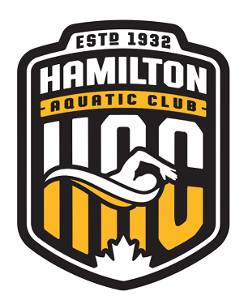Swimming Terms 101
Bell Lap: In the 800m or 1500m freestyle races a bell is rung as the swimmer approaches/leaves the wall for their last lap indicating that they only have 50m(short course) or 100m (long course) to swim.
Blocks: The starting platform located behind each lane.
Bulkhead: A wall constructed to divide a pool into different courses, such as a 50metre pool into two 25-meter courses.
Course: Designated distance (length of pool) for swimming competitions. Short Course (SC) = 25 meters / Long Course (LC) is 50 meters.
Deck: The area round the swimming pool reserved for swimmers, coaches and officials.
Deck Entry: Entries accepted into swimming events on the first day or later day of a meet.
DQ/Disqualified: This occurs when a swimmer has committed an infraction of some kind; e.g. freestyle kick in butterfly. A disqualified swimmer is not eligible to receive awards, nor can the time be used as an official time.
Dryland Training: Training done out of the water that aids and enhances swimming performance; usually includes stretching, calisthenics and/or weight training.
Event: A race or stroke over a given distance. An event equals one preliminary with its final, or 1 timed final.
Gutter: The area along the edge of the pool in which water overflows and is recirculated through the filtration system.
False Start: Occurs when a swimmer moves prior to the sounding of the start command.
Final: The championship heat of an event in which the top six or eight swimmers from the preliminaries compete, depending on the number of lanes in the pool.
Finish: The final phase of the race: the touch at the end of the race.
Flags: Backstroke flags placed 5 meters from the end of the pool. They enable backstroke swimmers to execute a backstroke turn more efficiently by counting their strokes.
Heat Sheet: The pre-meet printed listing of swimmers’ seed times and order of swimming in the various events at a swim meet.
Heats: Since there are only 8 lanes in which to race and usually many more swimmers the swimmers are divided into heats. i.e. 160 swimmers in the 50 freestyle = 20 heats. Heats are usually swum slowest to fastest with final three heats “Circle Seeded”.
I.M.: Shorthand for Individual Medley. An event in which the swimmer uses all four strokes on the following order: butterfly, backstroke, breaststroke, freestyle.
Lane Assignment: The lanes are typically filled from fastest to slowest in the following order: lane 4, 5, 3, 6, 2, 7, 1 and 8.
Long Course (LC): A pool 50 meters in length. Most long course meets occur in the spring and summer.
Relay: An event in which 4 swimmers compete together as a team to achieve one time.
Relay Events: Short Course: 4 x 50 free, 4 x 100 free, 4 x 200 free, 4 x 50 medley, 4 x 100 medley / Long Course: 4 x 50 free, 4 x 100 free, 4 x 200 free, 4 x 50 medley, 4 x100 medley.
Prelims: Slang for preliminaries, also called Heats or Trials. This races in which swimmers qualify for the championship and consolation finals in an event.
Sanction: An official status allowing an organization (swim club) to hold a swim meet. Meet must abide by all aspects of the sanction. All times for all events will be official and recognized by all governing bodies.
Scratch: To withdraw from an event in a competition.
Session: Portion of meet distinctly separated from other portions by locale, time, type of competition or age group. Most PCS-hosted meets have two sessions each day - the preliminaries heats are usually held in the morning session. The fastest six to eight swimmers, and in some events, the next fastest 6-8 swimmers will swim again in finals, if there are finals.
Short Course (SC): A pool 25 meter in length. Most short course meets occur in the fall and winter.
Split: The time it takes for a swimmer to swim a specific segment of the race. Most events can be broken down into equal segments of 25 or more commonly 50 meters. i.e. a 200 meter race has 4 x 50m segments. Each 50 meter segment could/would be timed. The splits for the race could be: :28.52 + :29.87 + :29.99 + :29.01. The first split is referred to as the “takeout” split.
Swim Off: When two (or more) swimmers finish the preliminaries in a “finals position” with the exact same time they will race the event again at the end of preliminaries (or an agreed to time before the finals) to establish seeding or placing. Swim Off times are official times.
Swimming Strokes: Freestyle, backstroke, breaststroke, butterfly, individual medley. These strokes all must be executed in accordance with the rules of swimming which you can view at www.swimming.ca/docs/2013%20Swimming%20Canada%20Rules.pdf
Time Standard: Also known as a Qualifying Time (QT). Some meets require swimmers to have met a qualifying standard prior to being entered in the meet. These standards are often set by the provincial section (Swim Ontario), the national section (SNC), the host organization, or by FINA.
Time Trial: A time-only swim that is not part of a regular meet.
Timed Final: The race is only raced once. This often happens for the longer distance races such as the 800m and/or 1500m and is done as a time saving measure. Slower heats in the preliminaries and fastest heat in the finals.
Touch Pad: A large touch sensitive board at the end of each lane where a swimmer’s touch is registered and sent electronically to the timing system.
Warm Down (Swim Down): Low intensity swimming used by swimmers after a race or main practice set to rid the body of excess lactic acid, and to gradually reduce heart rate and respiration.
Warm-Up: Low intensity swimming used by swimmers prior to a main practice or race to get muscles loose and warm and gradually increase heart rate and respiration.


